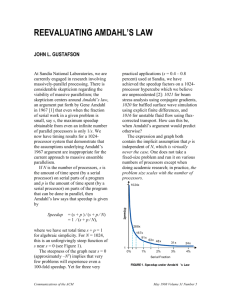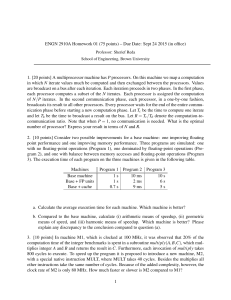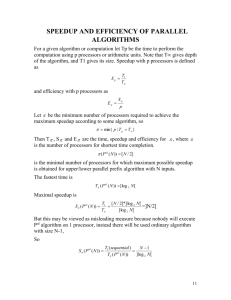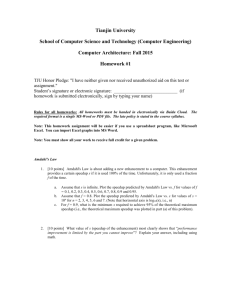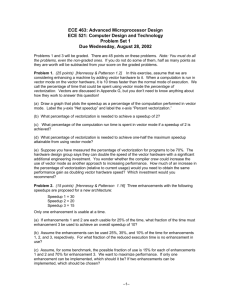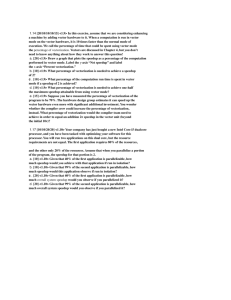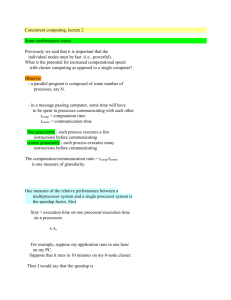Sandia National Laboratories
advertisement
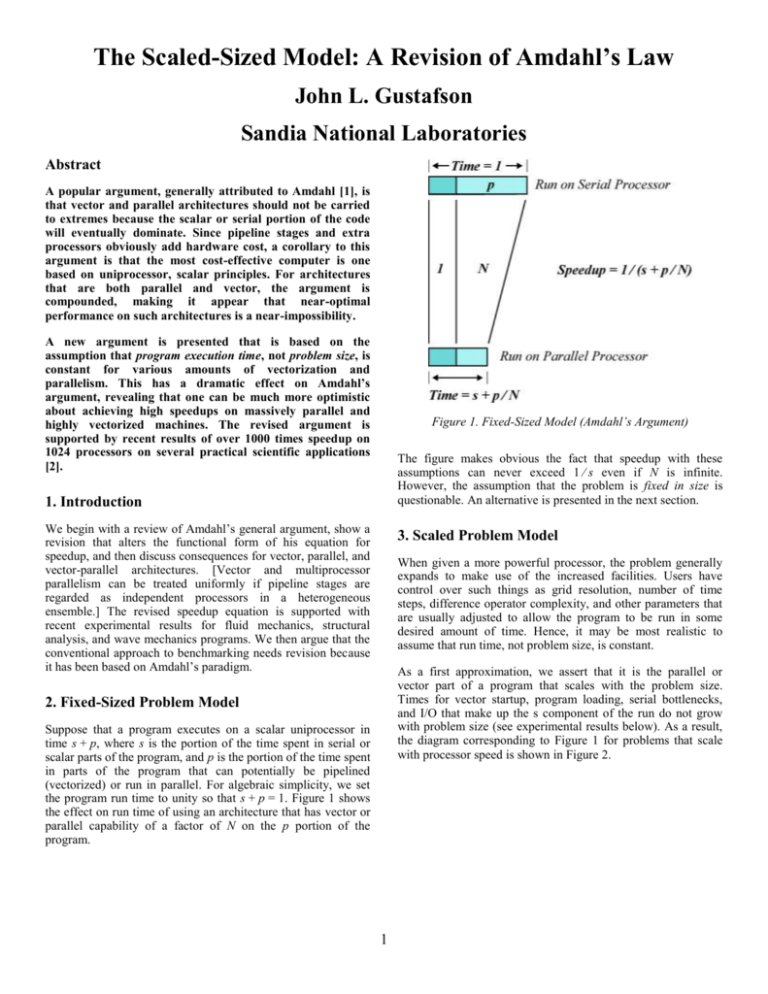
The Scaled-Sized Model: A Revision of Amdahl’s Law John L. Gustafson Sandia National Laboratories Abstract A popular argument, generally attributed to Amdahl [1], is that vector and parallel architectures should not be carried to extremes because the scalar or serial portion of the code will eventually dominate. Since pipeline stages and extra processors obviously add hardware cost, a corollary to this argument is that the most cost-effective computer is one based on uniprocessor, scalar principles. For architectures that are both parallel and vector, the argument is compounded, making it appear that near-optimal performance on such architectures is a near-impossibility. A new argument is presented that is based on the assumption that program execution time, not problem size, is constant for various amounts of vectorization and parallelism. This has a dramatic effect on Amdahl’s argument, revealing that one can be much more optimistic about achieving high speedups on massively parallel and highly vectorized machines. The revised argument is supported by recent results of over 1000 times speedup on 1024 processors on several practical scientific applications [2]. Figure 1. Fixed-Sized Model (Amdahl’s Argument) The figure makes obvious the fact that speedup with these assumptions can never exceed 1 ⁄ s even if N is infinite. However, the assumption that the problem is fixed in size is questionable. An alternative is presented in the next section. 1. Introduction We begin with a review of Amdahl’s general argument, show a revision that alters the functional form of his equation for speedup, and then discuss consequences for vector, parallel, and vector-parallel architectures. [Vector and multiprocessor parallelism can be treated uniformly if pipeline stages are regarded as independent processors in a heterogeneous ensemble.] The revised speedup equation is supported with recent experimental results for fluid mechanics, structural analysis, and wave mechanics programs. We then argue that the conventional approach to benchmarking needs revision because it has been based on Amdahl’s paradigm. 3. Scaled Problem Model When given a more powerful processor, the problem generally expands to make use of the increased facilities. Users have control over such things as grid resolution, number of time steps, difference operator complexity, and other parameters that are usually adjusted to allow the program to be run in some desired amount of time. Hence, it may be most realistic to assume that run time, not problem size, is constant. As a first approximation, we assert that it is the parallel or vector part of a program that scales with the problem size. Times for vector startup, program loading, serial bottlenecks, and I/O that make up the s component of the run do not grow with problem size (see experimental results below). As a result, the diagram corresponding to Figure 1 for problems that scale with processor speed is shown in Figure 2. 2. Fixed-Sized Problem Model Suppose that a program executes on a scalar uniprocessor in time s + p, where s is the portion of the time spent in serial or scalar parts of the program, and p is the portion of the time spent in parts of the program that can potentially be pipelined (vectorized) or run in parallel. For algebraic simplicity, we set the program run time to unity so that s + p = 1. Figure 1 shows the effect on run time of using an architecture that has vector or parallel capability of a factor of N on the p portion of the program. 1 Figure 3 applies whether we are dealing with a 64-processor system or a vector computer with 64-stage pipelines (64 times faster vector performance than scalar performance, similar to the ratio for memory fetches for the CRAY-2). Note in particular the slope of the graph at s = 0 in Figure 3. For Amdahl’s fixed-sized paradigm, the slope is d(speedup) ⁄ ds |s = 0 = N – N 2 (1) whereas for the scaled paradigm the slope is a constant: d(speedup) ⁄ ds |s = 0 = 1 – N (2) Comparison of (1) and (2) shows that it is N times “easier” to achieve highly-vectorized or highly-parallel performance for scaled-sized problems than for constant-sized problems, since the slope is N times as steep in Amdahl’s paradigm. Figure 2. Scaled Model Speedup It could well be that the new problem cannot actually be run on the serial processor because of insufficient memory, and hence the time must be extrapolated. Rather than ask, “How long will the current-sized problem take on the parallel computer?” one should ask, “How long would the new problem have taken on the serial computer?” This subtle inversion of the comparison question has the striking consequence that “speedup” by massive parallelism or vectorization need not be restricted to problems with miniscule values for s. 4. Experimental Results At Sandia, we have completed a study of three scientific applications on a 1024-node hypercube [2]. The applications are all readily scaled by the number of time steps and grid resolution (finite-element or finite-difference). We measured speedup by the traditional technique of fixing the problem size and also by scaling the problem so that execution time was constant. The resulting speedups are as follows: Architectures like hypercubes have memory distributed over the ensemble, so that a problem appropriate for a 1024-node hypercube would exceed the memory capacity of any one node by a factor of 1024. The simplest way to measure “speedup” on such a system is to measure the minimum efficiency of any processor (computation versus interprocessor communication overhead) and multiply by the number of processors. In striving for high efficiency, the functional form s + Np is far more forgiving than Amdahl’s 1 ⁄ (s + p ⁄ N), as illustrated in Figure 3 for N = 64. By careful management of the parallel overhead, all three applications showed speedups of several hundred even when a fixed-sized problem was spread out over 1024 processors (i.e., using 0.1% of available memory). However, as the global problem size was scaled to the number of processors (i.e., fixing the problem size per processor), the p portion of the problem grew linearly with the number of processors, N. Specifically, at N = 1024 we measured the increase in p to be 1023.9959 for the Beam Stress Analysis, 1023.9954 for Baffled Surface Wave Simulation, and 1023.9965 for Unstable Fluid Flow. Deviation from 1024 was caused primarily by small terms that grow as log N. When Amdahl’s Law is applied to the results of [2], it shows that four-hour runs were reduced to 20-second runs, of which about 10 seconds was caused by s and cannot be much further improved. But when run time is fixed by scaling the problem, the speedups indicate very little reason why even more massive parallelism should not be attempted. Figure 3. Scaled versus Fixed-Sized Speedup 131 5. Combination Vector-Parallel Architectures It is perhaps worth repeating that pipelining is a form of parallelism. As an example, Figure 4 shows a simplified diagram of an array processor and a low-order hypercube. Figure 4. Parallelism in Vector Processors and Ensembles The vector processor in Figure 4 has a 3-stage floating-point multiplier (FM1, FM2, FM3), 2-stage floating-point adder (FA1, FA2), and 3-stage memory unit (M1, M2, M3), whereas the hypercube has processors P0 to P7. The vector processor has special heterogeneous units with few options on the direction of output, whereas the ensemble on the right has general homogeneous units with three possible outputs from every unit. Nevertheless, both are parallel processors in the sense of Amdahl’s Law: hardware is wasted whenever an algorithm cannot make use of all the units simultaneously. Figure 5. Parallel-Vector Speedup (Fixed-Sized Model) With the notable exceptions of the NCUBE/ten hypercube (massively parallel but no vectors) and the Japanese supercomputers (multiple pipelines but only one processor), virtually all high-performance computers now make use of both kinds of parallelism: vector pipelines and multiple processors. Examples include the CRAY X-MP, ETA10, and FPS T Series. If we assume that Amdahl’s argument applies to both techniques independently, then speedup is the product of the parallel and vector speedups: Speedup = 1 ⁄ [(s1 + p1 ⁄ N1)(s2 + p2 ⁄ N2)], (3) where s1 is the scalar fraction, p1 is the pipelined fraction, N1 is the vector speedup ratio, s2 is the serial fraction, p2 is the parallel fraction, and N2 is the number of processors. An example is shown in Figure 5 for the case of the CRAY X–MP/4, where we estimate vector speedup N1 = 7. The figure makes near-optimal performance appear difficult to achieve. Even when parallel and vector content are only 50% of the total, the speedup ranges only from 7x to 11.2x. Now we apply the argument of Section 3; the scaled speedup, assuming independence of vector and parallel speedups, is Speedup = (s1 + N1p1)(s2 + N2p2), (4) which has the form shown in Figure 6. The speedup when parallel and vector content is 50% is now 16x to 17.5x, considerably higher than before even for such small values of N1 and N2. It is much easier to approach the optimum speedup of N1N2 than Amdahl’s Law would imply. Figure 6. Parallel-Vector Speedup (Scaled Model) 132 6. Benchmarks 7. Summary To the best of the author’s knowledge, no widely-accepted computer benchmark attempts to scale the problem to the capacity of the computer being measured. The problem is invariably fixed, and then run on machines that range over perhaps four orders of magnitude in performance. When comparing processor X to processor Y, it is generally assumed that one runs the same problem on both machines and then compares times. When this is done and X has far more performance capability than Y as the result of architectural differences (pipelines or multiple processors, for example), the comparison becomes unrealistic because the problem size is fixed. Because of the historical failure to recognize this, both vectorization and massive parallelism have acquired the reputation of having limited utility as a means of increasing computer power. A well-known example is the LINPACK benchmark maintained by J. Dongarra of Argonne National Laboratory [3]. The original form of the benchmark consisted of timing the solution of 100 equations in 100 unknowns, single-precision or doubleprecision, with or without hand-coded assembly language kernels. The problem requires about 80 KBytes of storage and 687,000 floating-point operations, and thus can be performed on even small personal computers (for which the task takes two or three minutes). When run on a supercomputer such as the CRAY X-MP/416 (8.5 nsec clock), the benchmark occupies only 0.06% of available memory, only one of the four processors, and executes in 0.018 seconds (less time then it takes to update a CRT display). The resulting 39 MFLOPS performance is only a few percent of the peak capability of the supercomputer, for reasons explainable by Amdahl’s Law. The seemingly disproportionate effect of a small scalar or serial component in algorithms vanishes when the problem is scaled and execution time is held constant. The functional form of Amdahl’s Law changes to one in which the slow portion is merely proportional rather than catastrophic in its effect. The constant-time paradigm is especially well-suited to the comparison of computers having vastly different performance capacities, as is usually the case when comparing highlyvectorized machines with scalar machines, or massively-parallel machines with serial machines. It seems extremely unrealistic to assume that a supercomputer would be used in this way. Recognizing this, Dongarra has added 300-equation and 1000-equation versions to his list, with dramatic effect on the observed performance. The 1000equation benchmark uses 6% of the CRAY memory and requires 669 million floating-point operations. With the problem so scaled, the solution requires 0.94 seconds, uses all four processors efficiently, and shows performance of 713 MFLOPS. It is fair to compare this with a scalar machine such as the VAX 8650 running the 100-equation problem, which takes about the same amount of time (0.98 seconds) and yields 0.70 MFLOPS. Thus, it is fair to conclude that the CRAY is 1020 times as fast as the VAX based on roughly constant-time runs, which may be a more representative comparison than the ratio of 56 that results from constant-sized problem runs. References [1] Amdahl, G., “Validity of the Single-Processor Approach to Achieving Large-Scale Computer Capabilities,” AFIPS Conference Proceedings 30, 1967, pp. 483–485. [2] Benner, R. E., Gustafson, J. L., and Montry, G. R., “Development and Analysis of Scientific Applications Programs on a 1024-Processor Hypercube,” SAND 880317, February 1988. [3] Dongarra, J. J., “Performance of Various Computers Using Standard Linear Equations Software in a Fortran Environment,” Technical Memorandum No. 23, Argonne National Laboratory, October 14, 1987. Perhaps one way to modify the LINPACK benchmark would be to solve the largest system of equations possible in one second or less, and then use the operation count to find MFLOPS. This allows a very wide range or performance to be compared in a way more likely to correlate with actual machine use. In one second, a personal computer with software floating-point arithmetic might solve a system of 10 equations at a speed of about 0.0007 MFLOPS. In the same amount of time, a supercomputer might solve a system of 1000 equations at a speed of about 700 MFLOPS—a million times faster than the personal computer. The same technique can be easily applied to any benchmark for which the problem can be scaled and for which one can derive a precise operation count for the purpose of computing MFLOPS. 133
